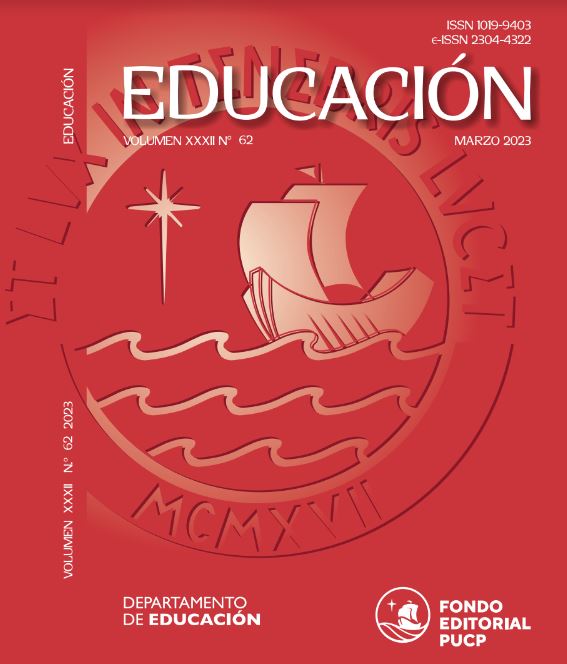Representaciones semióticas en el álgebra escolar: una revisión sistemática de la literatura entre 2013-2022
DOI:
https://doi.org/10.18800/educacion.202402.A004Palabras clave:
Representaciones semióticas, Registros semióticos, ÁlgebraResumen
El objetivo de este estudio fue conocer el estado actual del uso de diferentes representaciones semióticas en investigaciones de los procesos de enseñanza-aprendizaje del álgebra escolar realizadas entre 2013 y 2022. Dada su naturaleza, los estudiantes pueden acceder a los objetos matemáticos solo mediante representaciones, haciendo uso de signos y símbolos. El carácter predominantemente simbólico que presenta el estado de la matemática moderna hace pertinente cuestionarse la forma en que los estudiantes se apropian del conocimiento matemático. Para conocer el estado actual del uso de representaciones semióticas en el álgebra escolar por parte de estudiantes de educación media, se llevó a cabo una revisión sistemática, bajo un enfoque Prisma, que implicó un análisis de las temáticas y las fundamentaciones teóricas expuestas en los artículos tratados. Con esto se dio respuesta a qué tan diversas son las representaciones y qué principios teóricos respaldan los artículos. Asimismo, la revisión sistemática realizada revela una escasa investigación entre 2013 y 2022, un bajo porcentaje de estudios en América Latina, una diversidad notable en registros semióticos en la categoría de diseño y una fuerte preferencia por teorías socioculturales.
Descargas
Citas
Adell, J. S., Llopis, M. A. N., Esteve, M. F. M., & Valdeolivas, N. M. G. (2019). El debate sobre el pensamiento computacional en educación. RIED. Revista Iberoamericana de Educación a Distancia, 22(1), 171-186.
https://doi.org/10.5944/ried.22.1.22303
Alexander, P. (2020). Methodological Guidance Paper: The Art and Science of Quality Systematic Reviews. Review of Educational Research 90(1), 6-23. https://doi.org/10.3102/0034654319854352
Alonso, F., Barbero, C., Fuentes, I., Azcárate, A., Dozagarat, J., Gutiérrez, S., et al. (1993). Ideas y Actividades para enseñar álgebra. Síntesis.
Antonini, S., & Lisarelli, G. (2021). Designing Tasks for Introducing Functions and Graphs within Dynamic Interactive Environments. Mathematics, 9(5), 572. https://doi.org/10.3390/math9050572
Bagossi, S., Swidan, O., & Arzarello, F. (2022). Timeline tool for analyzing the relationship between students-teachers-artifacts interactions and meaning-making. Journal on Mathematics Education, 13(2), 357-382. http://doi.org/10.22342/jme.v13i2.pp357-382
Campo-Meneses, K. G., Font, V., García-García, J., & Sánchez, A. (2021). Mathematical Connections Activated in High School Students’ Practice Solving Tasks on the Exponential and Logarithmic Functions. Eurasia Journal of Mathematics, Science and Technology Education, 17(9).
https://doi.org/10.29333/ejmste/11126
Duval, R. (2004). Semiosis y pensamiento humano. Registros semióticos y aprendizajes intelectuales. Grupo de Educación Matemática.
Duval, R. (2006). Un tema crucial en la educación matemática: La habilidad para cambiar el registro de representación. La Gaceta de la Real Sociedad Matemática Española, 9(1), 143-168.
Erbilgin, E., & Gningue, S.M. (2023). Using the onto-semiotic approach to ana-lyze novice algebra learners’ meaning-making processes with different representations. Educational Studies in Mathematics, 114(2), 337-357. https://doi.org/10.1007/s10649-023-10247-8
Ferretti, F. (2019). The Manipulation of Algebraic Expressions: Deepening of a Widespread Difficulties and New Characterizations. International Electronic Journal of Mathematics Education, 15(1). https://doi.org/10.29333/iejme/5884
Florio, E. (2020). A Synergy between History of Mathematics and Mathematics Education: A Possible Path from Geometry to Symbolic Algebra. Educa-tional Sciences, 10(9), 243. https://doi.org/10.3390/educsci10090243
Hitt, F., & González-Martín, A.S. (2015). Covariation between variables in a modelling process: The ACODESA (collaborative learning, scientific de-bate and self-reflection) method. Educational Studies in Mathematics, 88, 201-219. https://doi.org/10.1007/s10649-014-9578-7
Kieran, C. (2007). Developing algebraic reasoning: The role of sequenced tasks and teacher question from the primary to the early secondary school levels. Quadrante, 16(1), 5-26. https://doi.org/10.48489/quadrante.22814
Ministerio de Educación de Chile. (2015a). Bases Curriculares de Primero Básico a Sexto Básico. MINEDUC.
Ministerio de Educación de Chile. (2015b). Bases Curriculares de Séptimo Básico a Segundo Medio. MINEDUC.
Ministerio de Educación de Chile. (2016). Programa de Estudio Matemática 1° Medio. MINEDUC.
Moher, D., Liberati, A., Tetzlaff, J., & Altman, D. (2009). Preferred Reporting Items for Systematic Reviews and Meta-Analyses: The PRISMA Statement. PLoS Medicine, 6(7). https://doi.org/10.1371/journal.pmed.1000097
Morey, B. (2020). Abordagem semiótica na teoria da objetivação. En S. T. Gobara & L. Radford (Eds.), Teoria da objetivação: Fundamentos e Aplicações para o Ensino e Aprendizagem de Ciências e Matemática (pp.43-68). Livraria da Física.
Monzon, L. W., & Gravina, M. A. (2013). Uma Introdução às Funções de Variável Complexa no Ensino Médio: Uma possibilidade através do uso de animações interativas. Bolema: Boletim de Educação Matemática, 27(46), 645-661. https://doi.org/10.1590/S0103-636X2013000300020
Mula-Falcón, J., & Caballero, K. (2022). Neoliberalism and its impact on academics: A qualitative review. Research in Post-Compulsory Education, 27(3), 373-390. https://doi.org/10.1080/13596748.2022.2076053
Mutodi, P., & Mosimege, M. (2021). Learning mathematical symbolization: Conceptual challenges and instructional strategies in secondary schools. Bolema: Boletim de Educação Matemática, 35(70), 1180-1199. https://doi.org/10.1590/1980-4415v35n70a29
Ninow, V., & Kaiber, C. (2019). Affine function: An analysis from the perspective of the epistemic and cognitive suitability of the onto-semiotic approach. Acta Scientiae. Revista de Ensino de Ciências e Matemática, 21(6), 130-149. https://doi.org/10.17648/acta.scientiae.5506
Osorio, V., Yáñez, P., Salazar, O., & Castro, J. (2021). Conflictos semióticos y niveles de algebrización en aspirantes a Ingeniería. Educación Matemática, 33(3), 263-289. https://doi.org/10.24844/em3303.10
Presmeg, N., Radford, L., Roth, W.-M., & Kadunz, G. (2016). Semiotics in Mathematics Education. Springer. https://doi.org/10.1007/978-3-319-31370-2
Presmeg, N., Radford, L., Roth, W.-M., & Kadunz, G. (Eds.). (2018). Signs of signification. Semiotics in Mathematics Education Research. Springer.
https://doi.org/10.1007/978-3-319-70287-2
Radford, L. (2008). The ethics of being and knowing: Towards a cultural theory of learning. En L. Radford, G. Schubring, & F. Seeger (Eds.), Semiotics in Mathematics Education: Epistemology, history, classroom, and culture (pp. 215-234). Sense Publishers.
Rojas, P. J. (2014). Mathematical objects, semiotic representations and senses. Enseñanza de las Ciencias. Revista de investigación y experiencias didácticas, 33(1), 151-165. https://doi.org/10.5565/rev/ensciencias.1479
Wu, H. (2001). How to prepare students for algebra. American Educator, 25(2), 10-17.









